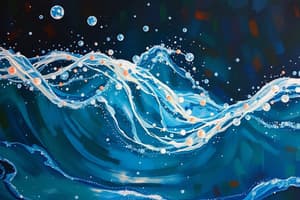Podcast
Questions and Answers
What did early Indian and Greek philosophers propose about atoms?
What did early Indian and Greek philosophers propose about atoms?
- Atoms are the smallest particles of matter
- Atoms consist of different energy levels
- Atoms are the fundamental building blocks of matter and are not further divisible (correct)
- Atoms are made up of electrons, protons, and neutrons
What is the meaning of the word 'atom' as derived from the Greek word 'a-tomio'?
What is the meaning of the word 'atom' as derived from the Greek word 'a-tomio'?
- Uncut-able or non-divisible (correct)
- Indivisible energy levels
- The smallest particle of matter
- Made up of protons, electrons, and neutrons
Who proposed the existence of atoms as the fundamental building blocks of matter?
Who proposed the existence of atoms as the fundamental building blocks of matter?
- Planck and de Broglie
- Thomson, Rutherford, and Bohr
- Early Indian and Greek philosophers (correct)
- Heisenberg and Pauli
What do the differences in the internal structure of atoms lead to?
What do the differences in the internal structure of atoms lead to?
What is the significance of the word 'atom' in relation to its divisibility?
What is the significance of the word 'atom' in relation to its divisibility?
What is the origin of the word 'atom' based on its meaning?
What is the origin of the word 'atom' based on its meaning?
Who proposed the atomic theory of matter in 1808?
Who proposed the atomic theory of matter in 1808?
Which scientist showed that if electricity is passed through an electrolyte, chemical reactions occurred at the electrodes?
Which scientist showed that if electricity is passed through an electrolyte, chemical reactions occurred at the electrodes?
What did the experiment with partially evacuated tubes, known as cathode ray discharge tubes, lead to the discovery of?
What did the experiment with partially evacuated tubes, known as cathode ray discharge tubes, lead to the discovery of?
What is the nature of the flow of current from cathode to anode in a cathode ray discharge tube?
What is the nature of the flow of current from cathode to anode in a cathode ray discharge tube?
Which scientist formulated certain laws related to the liberation and deposition of matter at the electrodes when electricity is passed through a solution of an electrolyte?
Which scientist formulated certain laws related to the liberation and deposition of matter at the electrodes when electricity is passed through a solution of an electrolyte?
What did John Dalton's atomic theory regard the atom as?
What did John Dalton's atomic theory regard the atom as?
What did Dalton's atomic theory successfully explain?
What did Dalton's atomic theory successfully explain?
Study Notes
Early Philosophical Proposals
- Early Indian and Greek philosophers, such as Democritus and the Jain philosophers, proposed that matter is made up of indivisible particles called atoms.
- They speculated on the fundamental nature of matter and the composition of the universe.
Meaning of 'Atom'
- The word 'atom' is derived from the Greek term 'a-tomio,' which means 'uncuttable' or 'indivisible'.
- This reflects the belief that atoms cannot be divided into smaller components.
Proponents of Atomic Theory
- Democritus is credited with the proposal of atoms as the fundamental building blocks of matter in ancient philosophical thought.
- John Dalton formalized the atomic theory of matter in 1808, presenting a scientific framework for atoms.
Internal Structure of Atoms
- Variations in the internal structure of atoms lead to the diversity of matter and the formation of different substances.
- These differences play a crucial role in chemical properties and reactions.
Significance of Atoms
- The term 'atom' underscores its essential quality of indivisibility, indicating that atoms were once thought to be the smallest units of matter.
- This notion of indivisibility has evolved with advances in science, revealing subatomic particles.
Historical Context of 'Atom'
- The origin of the word 'atom' conveys its initial meaning concerning matter's smallest components, reflecting ancient philosophical thought.
Discovery of Chemical Reactions
- Michael Faraday demonstrated that passing electricity through an electrolyte induces chemical reactions at the electrodes.
- This highlighted the connection between electricity and chemical changes in substances.
Cathode Ray Experiment
- Experiments using partially evacuated cathode ray discharge tubes uncovered the existence of electrons, which are fundamental subatomic particles.
- These experiments showed that electrical current flows from the cathode (negative electrode) to the anode (positive electrode).
Electrode Laws
- Faraday formulated specific laws governing the separation and deposition of materials at the electrodes during electrolytic processes.
- These laws articulated the quantitative relationship between electric charge and chemical changes.
Dalton's Atomic Theory
- John Dalton's atomic theory described the atom as a solid, indivisible sphere that constitutes all matter.
- Dalton successfully explained the principles of chemical combinations, mass conservation in reactions, and the uniqueness of different elements based on atomic composition.
Studying That Suits You
Use AI to generate personalized quizzes and flashcards to suit your learning preferences.
Description
Explore the discovery of electron, proton, and neutron along with their characteristics. Learn about the atomic models proposed by Thomson, Rutherford, and Bohr, and understand the quantum mechanical model of the atom. Gain insights into the nature of electromagnetic radiation and Planck's contribution.




